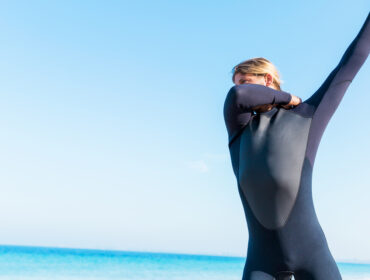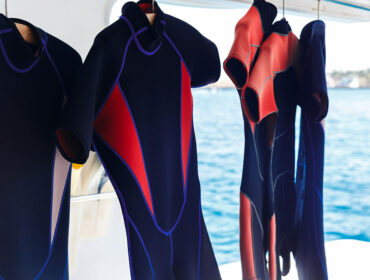Many people associate scuba diving with tropical climes, but in fact, divers will plunge into just about any temperature of water to get where they want to go. For this reason, wetsuits are made in varying thicknesses, ranging from 3mm to 7mm. However, there are water temperatures in which even the thickest wetsuit just won’t do, and this is when it’s time to climb into a drysuit.
A drysuit is different from a wetsuit in several ways. First, and most obviously, it is constructed to keep the wearer completely dry. While it is important to get the correct size for your build, drysuits appear rather baggy at first glance. This is so that insulating garments may be worn underneath the drysuit, and also to allow for inflation, which provides a measure of buoyancy along with a layer of air between the diver and the water to preserve body heat.
The openings are fitted with latex rubber or neoprene seals to fully enclose the wearer in an environment free of water. Of course, they are not immune from moisture due to sweat, but consideration is given to this issue through use of absorbent materials to wick away perspiration.
Drysuits can be considerably more expensive than wetsuits due to the precision and materials required to make them waterproof. The zippers used for drysuits were originally created by NASA to keep air inside an astronaut’s suit.
Most modern drysuits place the zipper diagonally across the torso, but on some models the zipper is placed on the back of the suit, spanning shoulder to shoulder. Because the zipper is required to be stiff to ensure its waterproof capabilities, the opening for the drysuit has to be placed strategically so that the wearer still has a wide range of mobility.
Some drysuits cannot be donned without the help of another person, but most try to address the need to be self-sufficient. Drysuits can be fitted with a fly for the purpose of urination. There are even specially made valves that can be integrated into the drysuit for urination, such as the OMS Pee Valve. Such devices can be installed for both males and females, allowing for longer dives when necessary.
Accessories for the drysuit include a hood, thermal undergarments, boots, and gloves or mittens. Some drysuits have permanently attached gloves and boots, while others cut off at the wrists and ankles, allowing the user to wear their preferred accessory. Additional seals can be attained to further ensure a tight waterproof closure between the drysuit and the accessory.
For occupational divers, a customized helmet can be part of the suit when required to be underwater for long stretches of time and recurring days. Weighted boots are also an option, as needed in the case of underwater construction where the diver is on the sea floor or a platform and needs to remain static.
The uses for drysuits include water sports, commercial activity, emergency, rescue, and recreation. Whatever the use may be, a drysuit is an invaluable part of the cold water diver’s gear. Hypothermia is possible even in relatively warm waters, so if you have any doubt at all, err on the side of safety and encase yourself in a drysuit!





